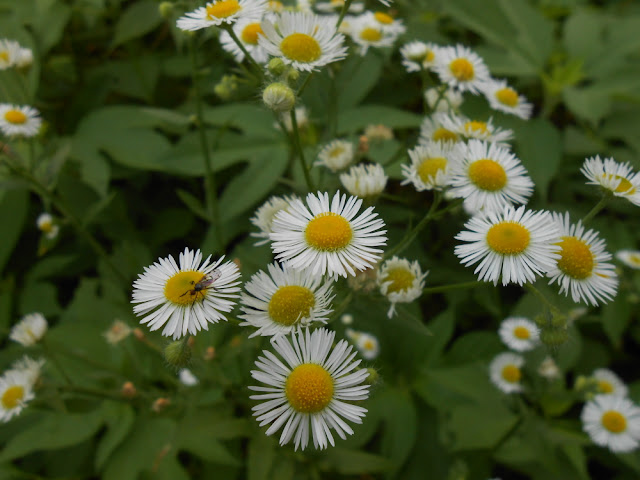Pretty darned good --- despite everything; although Kay may shoot me for using this photo of her watering yesterday afternoon --- unless I move fairly fast.
We call this the "heirloom garden" and it's located near the foot of the big hill at the west end of the Lucas County Historical Society museum campus. We decided to start reclaiming this underutilized area in the spring as part of the greening of our grounds.
Robin Kennedy and Jim Secor planted it in freshly-turned (by Jim) sod just a few weeks ago --- just before the monsoons set in and after weeks of chill. Jim has been weeding, replanting and mulching since; and Kay and Rex moved in yesterday with mini-tiller and hard labor on a hot day to clear an area where we've had a crop failure and replant --- heirloom beans. No guarantee of a crop, but at least something will be growing where sunflowers were intended.
Jim planted sunflowers once, then the rains came and the seed didn't germinate well. He replanted, they sprouted --- then critters ate them (this area is popular with deer). Time for a new strategy.
We're entirely aware that we should have started the whole process earlier --- like last fall. But we didn't.
The goal here during the first year is to just see what happens and build on that. We're not using any type of repellent or any form of commercial pesticide. What grows grows; what doesn't, doesn't. Nearly everything here originated from heirloom seeds.
This is an area of "three-sisters" planting --- beans inside a circle of corn with squash interspersed. Critters have lunched here occasionally, but you can get the idea.
Heirloom tomatoes --- three varieties planted and sprawling randomly in three rows --- are flourishing. This tiny yellow variety melts in your mouth --- there were several other ripe ones here, but Kay and I ate them before I remembered that I was holding a camera.
There's also cabbage, basil, onions, several varieties of melon and other stuff at the north end and old-fashioned flowers at the south end.
We're also beginning to work in an area below the garden optimistically called "the prairie." This area was carefully developed several years ago --- tilled and planted with appropriate seed from Osenbaugh Farms. Then the city rebuilt a sewer line right through it, disrupting everything --- and did not replant with appropriate seeds.
There's actually quite a lot left, however, including pale coneflowers, several varieties of grasses and other stuff. So the strategy for this year is going to be to pull the horse weed --- the only really aggressive intruder --- and then, next spring, burn the area and see what happens then.
If you want to find me a little later this morning, I'll be pulling horse weed.
Up at the top of the hill, flowers continue to flourish in several areas, but those can wait for another day. LCHS board members Kay Brown and Jim Secor have been leading this campus-wide project with a strong early assist from Robin Kennedy and extensive continuing support from Hugh Howe, Angie Garton and others.
We're entirely aware that we should have started the whole process earlier --- like last fall. But we didn't.
The goal here during the first year is to just see what happens and build on that. We're not using any type of repellent or any form of commercial pesticide. What grows grows; what doesn't, doesn't. Nearly everything here originated from heirloom seeds.
This is an area of "three-sisters" planting --- beans inside a circle of corn with squash interspersed. Critters have lunched here occasionally, but you can get the idea.
Heirloom tomatoes --- three varieties planted and sprawling randomly in three rows --- are flourishing. This tiny yellow variety melts in your mouth --- there were several other ripe ones here, but Kay and I ate them before I remembered that I was holding a camera.
There's also cabbage, basil, onions, several varieties of melon and other stuff at the north end and old-fashioned flowers at the south end.
We're also beginning to work in an area below the garden optimistically called "the prairie." This area was carefully developed several years ago --- tilled and planted with appropriate seed from Osenbaugh Farms. Then the city rebuilt a sewer line right through it, disrupting everything --- and did not replant with appropriate seeds.
There's actually quite a lot left, however, including pale coneflowers, several varieties of grasses and other stuff. So the strategy for this year is going to be to pull the horse weed --- the only really aggressive intruder --- and then, next spring, burn the area and see what happens then.
If you want to find me a little later this morning, I'll be pulling horse weed.
Up at the top of the hill, flowers continue to flourish in several areas, but those can wait for another day. LCHS board members Kay Brown and Jim Secor have been leading this campus-wide project with a strong early assist from Robin Kennedy and extensive continuing support from Hugh Howe, Angie Garton and others.










No comments:
Post a Comment